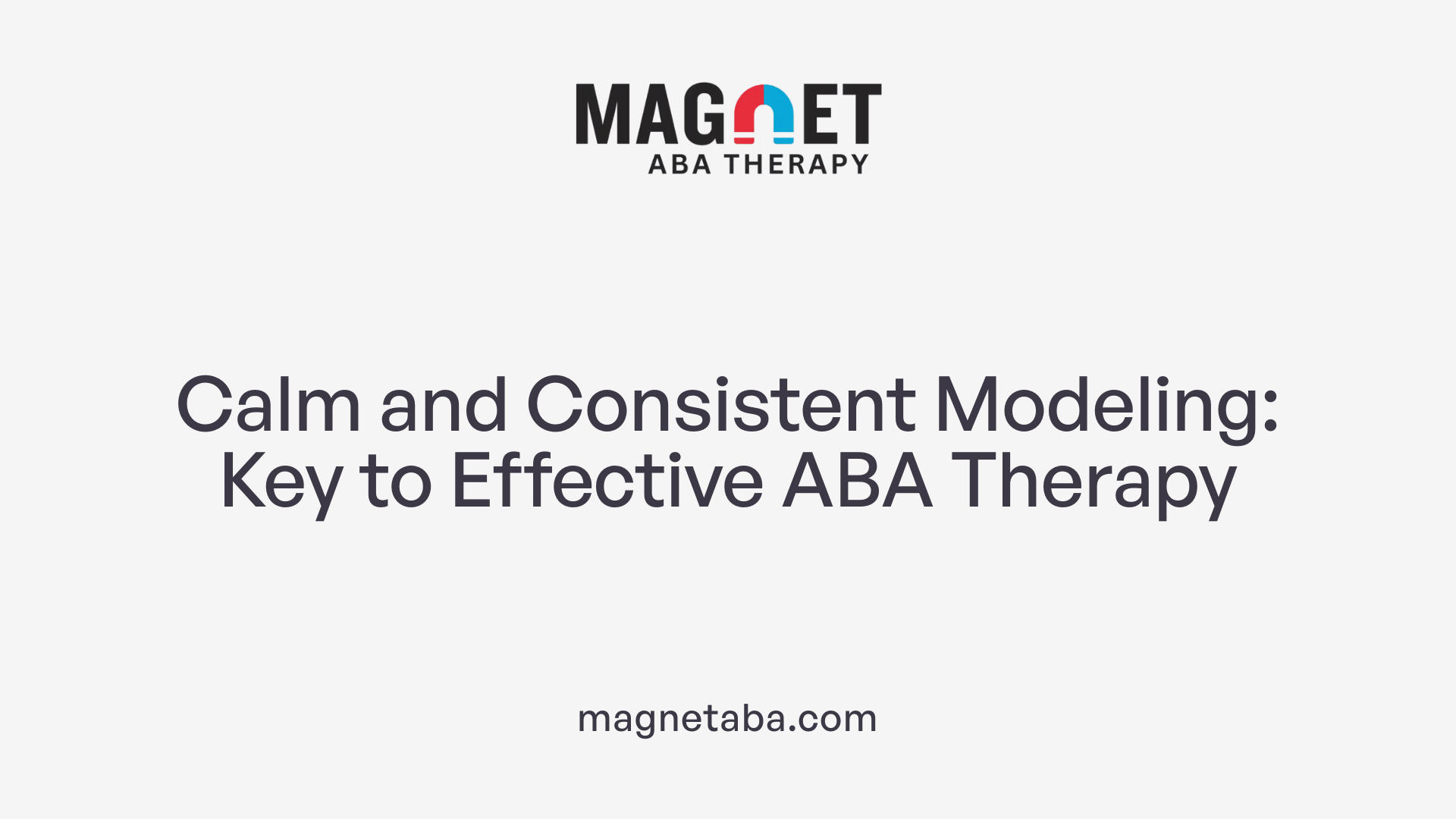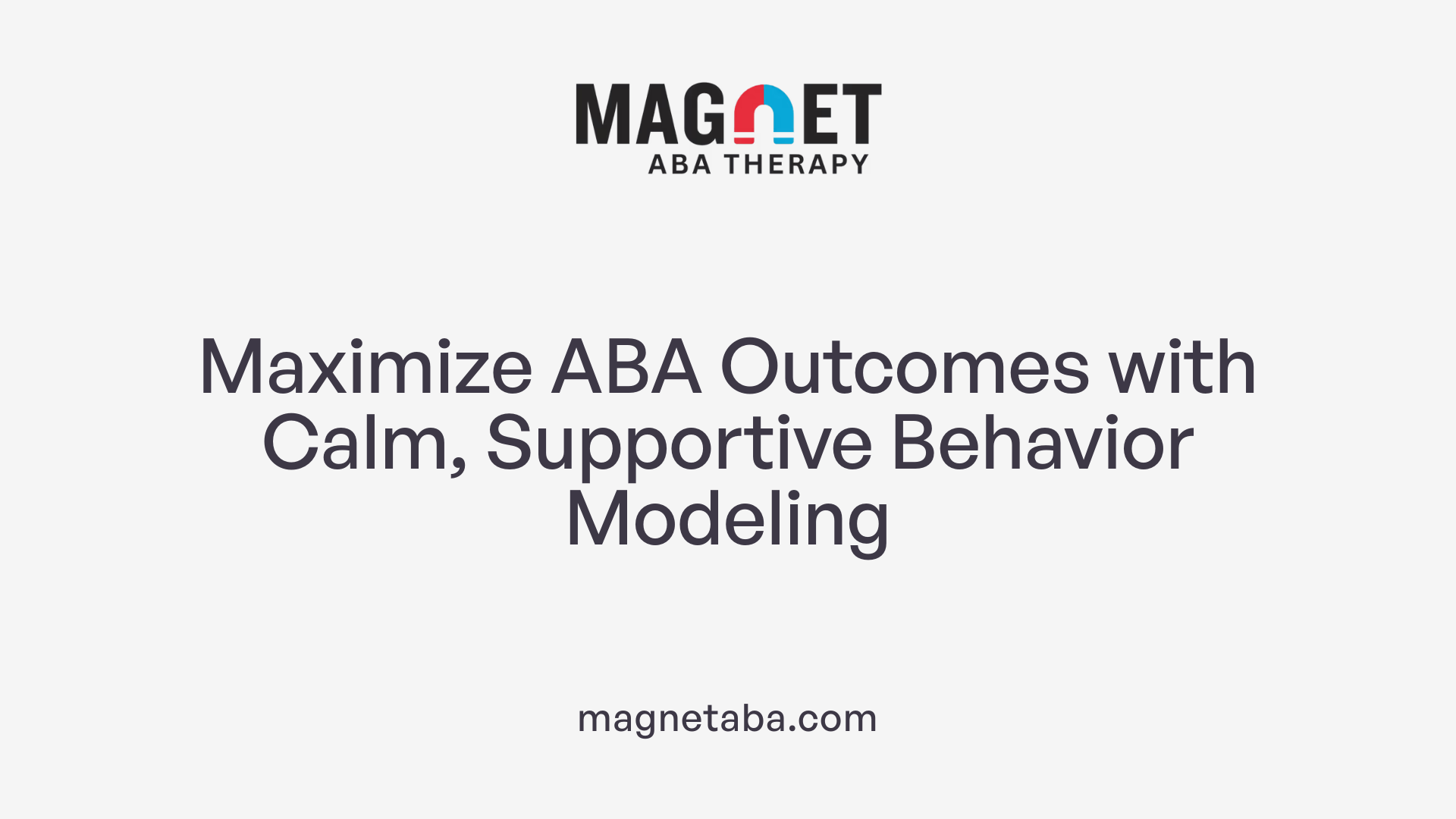The Role of Calmness in Behavioral Interventions
Applied Behavior Analysis (ABA) therapy plays a crucial role in supporting individuals with autism by enhancing communication, social, and daily living skills. One often overlooked element that significantly influences the success of ABA interventions is modeling calm behavior. This article explores how calmness modeled by therapists, caregivers, and educators can create a supportive environment for learning and anxiety management in children with autism.
Understanding ABA Therapy and Its Behavioral Foundations
What is Applied Behavior Analysis (ABA) therapy and how is it used to support individuals with autism?
Applied Behavior Analysis (ABA) therapy is a scientifically supported approach designed to understand and modify behavior, particularly effective for individuals with autism spectrum disorder (ASD). It targets increasing beneficial behaviors like communication, social skills, and everyday living activities while diminishing challenging behaviors. This is achieved by applying behavioral principles that focus on the relationships between antecedents (what happens before a behavior), the behavior itself, and consequences (what follows the behavior).
Behavioral principles underlying ABA
At its core, ABA studies how environmental factors influence behavior. By identifying triggers that precede a behavior (antecedents) and the outcomes that maintain it (consequences), therapists can develop strategies to encourage positive behaviors and reduce undesired ones. For example, positive reinforcement — providing a reward after a desired behavior — encourages the repetition of that behavior. Similarly, analyzing the antecedent-behavior-consequence (ABC) sequence helps create interventions tailored to each individual's unique needs.
Techniques used in ABA such as positive reinforcement and antecedent-behavior-consequence analysis
ABA employs a variety of techniques to teach and support individuals. Some key methods include:
- Positive Reinforcement: Encouraging good behavior by offering rewards or praise immediately after it occurs.
- Discrete Trial Training (DTT): Breaking skills into small, manageable steps and teaching them through repetition.
- Task Analysis and Chaining: Dividing complex tasks into simpler components and teaching each step in order.
- Functional Behavior Assessment (FBA): Identifying the purpose behind behaviors to modify them effectively.
- Antecedent-Based Interventions: Changing environmental triggers to prevent undesired behaviors from occurring.
By applying these techniques systematically, ABA therapy supports skill acquisition and behavior management in various settings such as schools, homes, and clinics. This personalized, data-driven approach helps individuals with autism achieve greater independence and improved social interaction.
Professional Roles in ABA and the Importance of Consistent Calm Modeling

What types of professionals provide ABA therapy for autism?
ABA therapy is primarily delivered by trained professionals such as Board Certified Behavior Analysts (BCBAs) and Registered Behavior Technicians (RBTs). BCBAs design and oversee individualized treatment plans, ensuring the application of behavioral principles tailored to each child's unique needs. RBTs implement these interventions directly with clients, working under BCBA supervision to apply techniques like positive reinforcement and task analysis. Other specialists, including licensed psychologists or therapists trained in ABA, may also contribute, offering a multidisciplinary approach.
Role of Board Certified Behavior Analysts (BCBAs) and Registered Behavior Technicians (RBTs)
BCBAs play a critical role in assessing behaviors and developing effective strategies that promote independence and reduce challenging behaviors. They conduct functional behavior assessments and design interventions leveraging techniques such as Discrete Trial Training and Pivotal Response Training. Registered Behavior Technicians provide hands-on implementation of these methods, delivering consistent and structured support in various settings like schools, clinics, or homes.
How calm demeanor from professionals influences treatment outcomes
The consistent calm and composed modeling by ABA professionals significantly impacts treatment success. When therapists and technicians maintain a calm demeanor, it creates a supportive environment that helps children with autism better manage anxiety and reduces behavioral escalation. This steady presence fosters trust and encourages children to engage in coping mechanisms and skill-building activities effectively. Incorporating calm interpersonal interaction aligns with ABA’s emphasis on positive reinforcement and structured learning, enhancing long-term outcomes.
Together, these professional roles and their mannerisms form a comprehensive support system vital for empowering children with autism to develop essential skills and navigate their environments confidently.
Customizing ABA Treatment Plans: The Role of Environment and Emotional Climate

How do specialized companies that offer ABA therapy customize treatment plans for individuals with autism?
Specialized companies use a comprehensive approach to develop individualized ABA treatment plans. They begin with detailed assessments to understand each child's unique strengths, challenges, and interests. This helps to identify specific goals focused on communication, social skills, adaptive behaviors, and reducing problematic behaviors.
Board-certified behavior analysts (BCBAs) play a central role in designing these plans. They apply evidence-based strategies such as positive reinforcement and task analysis, tailoring each technique to suit the child’s learning style and preferences. Collaboration with families ensures the child’s natural environments—like home and school—are incorporated effectively.
Continuous data collection and analysis are crucial. Therapists track progress closely and make data-driven adjustments to keep the intervention effective and relevant over time.
Incorporating calm environments and emotional regulation strategies
Creating a supportive emotional climate is vital. Treatment plans often include strategies that promote calmness, such as establishing safe spaces and using sensory tools like weighted blankets. Integrating emotional regulation techniques helps children learn coping mechanisms to handle anxiety triggers.
These calm environments combined with personalized ABA interventions empower children to generalize coping skills across various settings, enhancing long-term emotional well-being.
Use of data-driven adjustments
Therapists continuously monitor behaviors and outcomes using objective data. This ongoing evaluation allows for flexible modifications in goals and techniques, ensuring the approach remains responsive to the child’s developmental progress and emotional needs.
By combining individualized goal-setting, emotional support, and data-driven flexibility, specialized ABA therapy companies create holistic treatment plans that support both skill growth and anxiety management in children with autism.
Modeling Calm Behaviors to Manage Anxiety in Children with Autism
How ABA addresses anxiety triggers and coping mechanisms
Applied Behavior Analysis (ABA) provides a structured approach to managing anxiety in children with autism by identifying the specific triggers that cause distress. ABA breaks down these complex anxiety-inducing situations into smaller, manageable steps, enabling children to gradually build coping mechanisms. Personalized interventions are designed to help children develop skills needed to face anxiety-provoking scenarios effectively and apply these skills across different settings such as home, school, or therapy.
Importance of calm behavior from therapists and caregivers
Therapists and caregivers play an essential role in modeling calm behaviors, which is a critical aspect of ABA therapy for anxiety management. Children often mirror the emotional responses of adults around them, so when caregivers demonstrate calmness during stressful moments, it helps the child learn how to regulate their own emotional responses. This calm modeling supports children in feeling safe and secure, reducing their anxiety levels and promoting positive behavioral outcomes.
Specific strategies like creating safe spaces and sensory tools
ABA incorporates practical strategies to help children manage anxiety, including the creation of safe spaces where children can retreat when feeling overwhelmed. Sensory tools, such as weighted blankets or calming fidget devices, are integrated to help regulate sensory input and soothe the child. Additionally, ABA promotes various communication methods tailored to the child's needs, encouraging self-soothing techniques that empower children to regain control and calm themselves during anxious moments.
Together, these approaches within ABA form a comprehensive system that supports children with autism in navigating anxiety by fostering calmness both through modeled behavior and practical coping tools.
Benefits of ABA Therapy Enhanced by Calm and Supportive Modeling

What are the common benefits and outcomes of ABA therapy for children with autism?
ABA therapy offers significant improvements in key areas such as communication skills, social interactions, and daily living abilities for children with autism. Through structured techniques like Positive Reinforcement and Task Analysis, children experience reductions in problematic behaviors. Tailored strategies help meet each child's unique needs, fostering measurable progress in language development and independence. This enhanced skill set enables better integration into school and community settings, enriching their social participation and overall quality of life.
How does calm modeling reinforce positive behaviors and reduce anxiety?
Calm and supportive modeling plays a vital role in ABA therapy by providing children with a consistent example of composed behavior. When therapists or caregivers demonstrate calm interactions, it helps reduce anxiety in children, making them feel safe and understood. This environment promotes learning and encourages children to imitate positive behaviors. The calm demeanor of the support system acts as a regulating influence, helping children manage their emotional responses and feel more confident in challenging situations.
How do calm interactions aid skill generalization across settings?
Calm interactions facilitate the generalization of learned skills by creating a predictable and reassuring context for children. When children observe calm behavior during therapy and within their home or school environments, they are more likely to transfer coping mechanisms and social skills across these settings. This consistency supports better retention and application of skills, whether it be communication, self-soothing techniques, or social engagement. By fostering calmness, ABA enables children to navigate diverse environments with greater ease and independence.
Challenges and Criticisms: Ensuring Compassionate, Person-Centered ABA
What criticisms or limitations exist regarding ABA therapy as a treatment for autism?
Applied Behavior Analysis (ABA) therapy has faced criticisms related to its traditional focus and the ways it is delivered. Some critics argue that ABA can overly prioritize compliance and behavior modification, potentially overlooking the individual's emotional well-being and natural neurodiversity. This focus may sometimes lead to repetitive tasks that feel demanding or stressful to the child if not presented with sensitivity.
Concerns also arise around suppressing natural behaviors such as stimming or avoiding eye contact. These behaviors can be important for self-regulation, comfort, and expression in individuals with autism. Suppressing them without understanding their purpose might negatively impact emotional health.
Additionally, past uses of aversive techniques in ABA have sparked worry; while modern ABA emphasizes positive reinforcement and ethical practices, variability in treatment quality still exists. These criticisms highlight the importance of delivering ABA therapy in a compassionate, person-centered way that respects children's emotions and individuality.
To address these challenges, ethical ABA practices increasingly focus on calmness, respect, and collaboration with families. Ensuring that therapy supports holistic development rather than just behavior change helps promote long-term positive effects. By integrating sensitivity and individualized approaches, ABA can be both effective and nurturing for children on the autism spectrum.
Family and Caregiver Roles: Collaborating with Calmness to Reinforce ABA Success

Importance of caregiver involvement
Caregivers play an essential role in the effectiveness of ABA therapy. Their active participation helps reinforce the skills children learn during sessions, ensuring consistent practice and support in daily life. Involvement also strengthens the child’s comfort and trust, creating an emotional environment conducive to learning.
How families can model calm behavior to support learning
Families can support their child by modeling calm and composed behavior in stressful situations. This calmness helps children with autism manage anxiety and better absorb coping strategies. Demonstrating patience and positive reactions encourages children to mirror these responses, promoting emotional regulation and reducing challenging behaviors.
Collaboration between families and therapists to create consistent emotional environment
A strong partnership between families and ABA therapists is vital for creating a consistent emotional and behavioral framework. Therapists guide families on personalized strategies to manage anxiety triggers and reinforce coping mechanisms. Frequent communication ensures everyone remains aligned, supporting the child’s progress across home, school, and therapy environments.
How can families and caregivers find reputable providers of ABA therapy?
Families and caregivers can find reputable ABA therapy providers by conducting careful research, including exploring directories from professional organizations like the Behavior Analyst Certification Board (BACB). It is important to confirm that therapists are certified Board Certified Behavior Analysts (BCBAs) and comply with state licensing requirements. Recommendations from healthcare providers and local autism groups, along with reading other families’ reviews, also help identify trustworthy options. Scheduling consultations before committing allows families to ensure the therapy approach is tailored to their child’s unique needs.
Integrating ABA with Other Therapies: Occupational Therapy and Sensory Supports

Compatibility and synergy of ABA and occupational therapy
Applied Behavior Analysis (ABA) and occupational therapy (OT) are complementary approaches that, when integrated, can enhance support for children with autism spectrum disorder (ASD). While occupational therapists commonly apply developmental and sensory strategies, there's growing recognition that ABA's behavior-focused techniques align well with OT goals. Both disciplines emphasize individualized care, and combining ABA's behavior analysis with OT's sensory supports could improve outcomes by addressing a wider range of needs simultaneously.
Use of sensory tools like weighted blankets
Sensory tools play a vital role in supporting children with autism, particularly in managing anxiety and self-regulation. Weighted blankets, commonly used in occupational therapy, provide calming deep-pressure input that helps reduce stress levels. When incorporated alongside ABA's behavioral strategies, such sensory aids can create a more soothing environment, facilitating better engagement and learning. This blend allows children to feel safer and more relaxed while working on ABA-driven goals.
Incorporating calm behavior to improve overall treatment efficacy
ABA interventions emphasize teaching coping mechanisms and encouraging self-soothing techniques to manage anxiety. Occupational therapy supports this by addressing sensory integration and promoting calm behavior through environmental modifications and sensory-based activities. Together, these therapies foster emotional regulation and reduce disruptive behaviors. This integrated approach nurtures independence and improves social interaction skills, contributing to a positive and effective treatment experience across school, home, and therapy settings.
Calmness as a Cornerstone in ABA Therapy
Modeling calm behavior is essential in maximizing the effectiveness of Applied Behavior Analysis therapy for individuals with autism. Calmness from therapists, caregivers, and educators fosters emotional regulation, reduces anxiety, and supports skill acquisition. While ABA remains a leading evidence-based approach, integrating compassionate, person-centered techniques that emphasize calmness ensures that therapy respects both behavioral progress and emotional wellbeing. Families, professionals, and therapy providers working together under this shared calm approach can empower children with autism to achieve their fullest potential in varied environments.
References
- Autism and Anxiety: Treatment Options and ABA Techniques
- Applied Behavior Analysis, Autism, and Occupational Therapy
- 13 Applied Behavior Analysis Examples
- Applied Behavior Analysis (ABA)
- Why Customized ABA Therapy Plans Matter
- Applied Behavior Analysis (ABA)
- ABA Therapy Services in New York
- Applied Behavior Analysis Providers
- The Controversy Around ABA
- Concerns About ABA-Based Intervention: An Evaluation and ...












